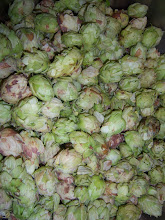 I am using were the lovely gift of my nextdoor neighbors, the Smiths. I’ll just thank my lucky stars they are too busy to make use of them, and brew away. Oh, the deliciousness!
I am using were the lovely gift of my nextdoor neighbors, the Smiths. I’ll just thank my lucky stars they are too busy to make use of them, and brew away. Oh, the deliciousness!
130. Cascade Fresh Hop
Mash:
8 lbs. Rahr 2-row
1 lb. MFB Vienna
1lb. Breiss White WheatMash @ 151° F for 65 minutes w/ 3 ½ gallons of RO water & 4 g. gypsum; collected 2 ¼ gallons @ 1.080
Batch sparge @ 166° F for 20 minutes w/ 4 gallons RO water; collected 4 gallons @ 1.022
Collected 6 ¼ gallons; topped off to 6 ¾ gallons; brought to a boil (60 minutes), & added:
w/60 to go: 4.75 oz. fresh Cascade
w/20 to go: 3 oz. fresh Cascade
w/15 to go: 1 tsp. Irish Moss
w/10 to go: 2 oz. fresh Cascade
w/5 to go: 2 oz. fresh Cascade
w/0 to go: 3 oz. fresh Cascade
Chilled, racked to carboy, & pitched Wyeast 1272 American Ale II
Brewed: 10/7/2012
Secondary: 10/13/2012 @ 1.012
Bottled: 11/14/2012 w/ 3.0 oz. table sugar
OG: 1.048
FG: 1.008
Tasting Notes: Cascade Fresh Hop pours a hazy dirty straw; while it has the same grain as 131. The Last Fresh Wild Hop (and pretty much the same process with the exception of the hops used), this one is certainly hazier in the glass. The head is creamy, white, and profuse, with good retention and offering some lacing on the glass. The nose is a mix of spicy floral and fruit hop aromas in the front, with grass and hay coming in after that; when I first had this beer, there was a distinct berry note in the front—strawberry, in fact—that has faded. There is none of the classic grapefruit you’d expect to find in Cascade; the fruitiness might hit lemon, but barely. Still, the hop aromas in the nose are subtle and beguiling. I get a touch of candy sweetness in the nose as well, and this
 reappears in the flavors of the front of the
beer, which starts with light cracker and candy malt sweetness. The hop flavor
comes in on the heels of the sweetness, starting with a resin spiciness mixed
with grass that is clean and brisk, and leads into the gentle bitterness of the
middle. There is also some hay and pine in the middle along with a touch of
bread crust from the malt, while the finish is clean and crisp. I get a touch
of floral hop flavor and candy malt, along with a gentle, even hop bitterness.
The gentle, creamy carbonation rounds the beer on the palate—it is smooth and
even, and the lighter body allows subtlety to play across the tongue. All in
all, this is certainly the best of the fresh hop beers I made this year, and it
also does have some actual bitterness from the hops—the only other one that had
any actual hop bitterness was the aforementioned 131. The Last Wild Fresh Hop, and that was
because I used commercial Willamette for bittering. As well, the MFB Vienna was
a good call as a replacement for any caramel or crystal malt; there is a touch
of sweetness, but nothing big enough to impinge upon the delicate components of
the fresh hops. I might try pushing it a bit next time—something like Dingemans Cara 20,
but I also like the pared-down body here—it serves more as a backdrop for the
fresh hops. I’ll have to expand my fresh hop operations next year. My secret
plan: a fresh hop saison. Not that that would actually surprise anyone.
reappears in the flavors of the front of the
beer, which starts with light cracker and candy malt sweetness. The hop flavor
comes in on the heels of the sweetness, starting with a resin spiciness mixed
with grass that is clean and brisk, and leads into the gentle bitterness of the
middle. There is also some hay and pine in the middle along with a touch of
bread crust from the malt, while the finish is clean and crisp. I get a touch
of floral hop flavor and candy malt, along with a gentle, even hop bitterness.
The gentle, creamy carbonation rounds the beer on the palate—it is smooth and
even, and the lighter body allows subtlety to play across the tongue. All in
all, this is certainly the best of the fresh hop beers I made this year, and it
also does have some actual bitterness from the hops—the only other one that had
any actual hop bitterness was the aforementioned 131. The Last Wild Fresh Hop, and that was
because I used commercial Willamette for bittering. As well, the MFB Vienna was
a good call as a replacement for any caramel or crystal malt; there is a touch
of sweetness, but nothing big enough to impinge upon the delicate components of
the fresh hops. I might try pushing it a bit next time—something like Dingemans Cara 20,
but I also like the pared-down body here—it serves more as a backdrop for the
fresh hops. I’ll have to expand my fresh hop operations next year. My secret
plan: a fresh hop saison. Not that that would actually surprise anyone.

No comments:
Post a Comment